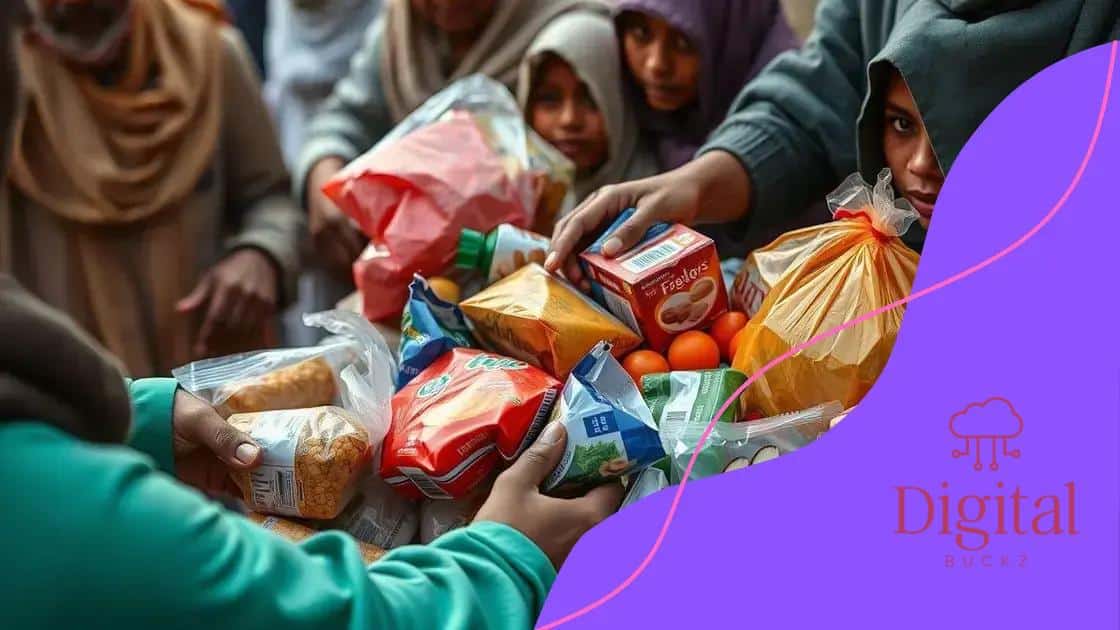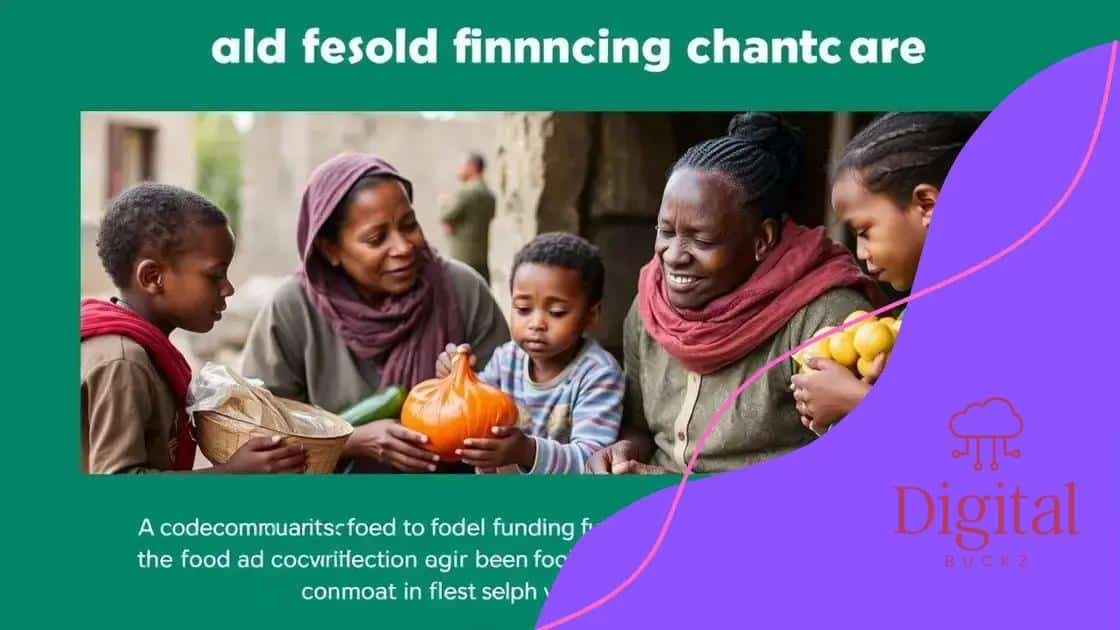Food aid funding shifts occur: what you need to know

Food aid funding shifts occur largely due to global crises, policy changes, and the need for sustainable solutions, directly impacting the efficiency and effectiveness of humanitarian assistance to vulnerable populations.
Food aid funding shifts occur with remarkable frequency, influencing how resources reach those in need. Have you ever wondered how these changes affect global communities? Let’s dive deeper into this dynamic topic.
Understanding recent trends in food aid funding
Understanding recent trends in food aid funding is crucial for grasping how aid reaches those in need. In recent years, we have seen shifts influenced by various factors, including global crises and changes in donor priorities. These shifts are not just numbers; they represent the lives of people affected by decisions made far away.
Key Trends in Food Aid Funding
Several key trends are shaping the landscape of food aid. A noticeable move towards flexible funding channels has emerged, which allows organizations to respond faster to emergencies.
- Increased focus on local sourcing of food.
- Emphasis on long-term developmental projects.
- Shifts in funding from traditional donors to private sector contributors.
This adaptability is particularly vital during crises like natural disasters or economic downturns. Donor countries and organizations are recognizing the importance of supporting not just immediate needs but also sustainable development. Additionally, there’s a heightened focus on transparency within funding processes to ensure aid reaches the right places.
Impact of Global Events
The impact of global events cannot be underestimated. Crises such as pandemics or conflicts tend to lead to increased funding for food aid as countries rally to address urgent needs. However, these funding responses are often short-term. It is essential to recognize how different events reshape the priorities of funding agencies.
For example, during the COVID-19 pandemic, many countries saw a dramatic increase in food aid requests. As a result, many organizations adapted their strategies, finding innovative ways to deliver aid without compromising safety. This situation illustrates the adaptability required in evolving funding landscapes.
Furthermore, integrating local communities into planning and implementation processes has proven beneficial. By involving them, funding can be much more effective in addressing specific needs. In doing so, we ensure that food aid is not only received but welcomed by those it aims to help.
Technological Advancements
Lastly, technological advancements are transforming food aid funding. Tracking donations and ensuring they reach intended recipients has become more streamlined. Technologies such as blockchain provide organizations with the ability to enhance accountability and traceability within funding frameworks.
As food aid funding continues to evolve, understanding these recent trends helps us stay informed and engaged with a global issue that affects millions. It is a dynamic field where every shift can mean a change in the lives of those who rely on support.
Key factors driving funding shifts
Understanding the key factors driving funding shifts in food aid is essential for grasping why resources may fluctuate. These factors come from various sources and can change based on crises, global politics, and economic conditions. Adjustments in funding can significantly affect the delivery of aid.
Global Crises
One major factor includes global crises, such as natural disasters or pandemics. Events like these increase the urgency for food aid, compelling governments and organizations to allocate more funds quickly.
- Natural disasters often create immediate food shortages.
- Health crises can disrupt food supply chains.
- Economic downturns lead to increased vulnerability among populations.
In many cases, these situations lead to an immediate reallocation of resources to meet urgent needs. For example, during the COVID-19 pandemic, food recipients faced heightened challenges, prompting increased funding from various sources.
Policy Changes
Policy changes also play a significant role. Governments may amend their foreign aid policies, focusing on specific areas or altering the criteria under which aid is distributed. Donor countries often evaluate their funding objectives every few years, which can significantly impact how much aid is available globally.
In addition, shifts in political relations can lead to changes in funding priorities. As certain countries form new partnerships, they may direct funds towards different regions, which can alter the food aid landscape.
Another important aspect is the role of non-governmental organizations (NGOs) and private sectors. They often step in to fill funding gaps, but their available resources can shift as priorities change. This dynamic landscape emphasizes the need for flexible funding mechanisms that can respond efficiently to the changing needs of communities.
Public Awareness and Advocacy
Finally, public awareness and advocacy efforts influence funding decisions. Increased visibility of food insecurity issues leads to greater public pressure on governments and organizations to take action.
As more people become aware of the challenges faced by those in need of food assistance, funding allocations may increase as a direct response to advocacy. Grassroots campaigns can highlight specific issues and drive home the necessity for funding changes. This growing awareness shapes how food aid systems operate and respond to needs.
Impact of funding changes on communities

The impact of funding changes on communities is profound and far-reaching. When shifts in food aid funding occur, they can alter the landscape of available resources, directly affecting individuals and families relying on assistance. Understanding how these changes ripple through communities helps us see the larger picture.
Immediate Effects on Food Security
One of the most immediate consequences of funding changes is the effect on food security. A sudden decrease in funding can lead to reduced support for food banks and local organizations.
- Increased hunger and malnutrition among vulnerable populations.
- Fewer resources for community gardens and local farms.
- Increased reliance on processed foods as fresh options become scarce.
When funding is inconsistent, communities are left to scramble for solutions. This can lead to food scarcity and heightened anxiety among residents as they worry about where their next meal will come from.
Long-Term Development Challenges
Beyond immediate needs, changes in funding also affect long-term development initiatives. Many communities rely on stable funding to pursue projects aimed at improving overall community health, education, and economic opportunities.
For example, educational programs about nutrition may be scaled back, affecting how families make food choices. Furthermore, investment in agricultural training programs may dwindle, limiting community members’ ability to grow their food sustainably.
As funding fluctuates, the ability of communities to develop and implement long-term solutions diminishes significantly. This creates a cycle where the community becomes less resilient over time.
Social and Economic Consequences
The social fabric of a community is also impacted by funding changes. When food aid is insufficient, it can lead to social unrest and increased poverty levels.
Families may face difficult choices, deciding between essential needs such as food and bills. This can lead to rising tensions among community members as more people compete for limited resources. The psychological toll can further hinder growth and development.
Communities that once thrived on cooperation may see divisions emerge, impacting local relationships and support networks. By understanding these consequences, we can appreciate the important role stable funding plays in community well-being.
Role of international organizations in aid distribution
The role of international organizations in aid distribution is vital to ensuring that food reaches those in need. These organizations act as bridges between donations and communities, facilitating the flow of resources across borders. Their work is crucial in responding to crises and supporting sustainable development.
Coordination of Efforts
International organizations coordinate efforts among various stakeholders, including governments, NGOs, and local groups. They help to streamline processes, making sure that aid is delivered efficiently.
- Establishing clear communication channels between donors and recipients.
- Mapping needs to understand where aid is most urgently required.
- Implementing standardized procedures to improve efficiency.
This coordination is essential, especially in emergency situations, where time is of the essence. By uniting diverse efforts, they can maximize the impact of each contribution.
Funding and Resource Mobilization
These organizations are also key players in mobilizing funding for food aid. They often work with various governments and private sector partners to gather resources needed for large-scale initiatives.
Additionally, international organizations advocate for policy changes that prioritize food security. Through their influence, they can secure more stable funding and prioritize assistance where it is most needed.
They often hold conferences and forums to raise awareness about food shortages and encourage investment in food security. Their ability to connect key players helps to align interests and create a united front against hunger.
Implementing Sustainable Solutions
Beyond immediate aid, international organizations focus on implementing sustainable solutions. They prioritize long-term strategies that empower communities rather than create dependency.
Programs like agricultural training and resource management are critical for building resilience. By equipping communities with knowledge and tools, these organizations ensure that future generations can thrive.
Moreover, international organizations often facilitate partnerships between local and global entities, ensuring that sustainable practices are rooted in the community. This collaboration fosters a sense of ownership and investment in long-term success.
Future outlook for food aid funding strategies
The future outlook for food aid funding strategies is shaped by the ongoing evolution of global challenges and resource availability. As the world faces increasing threats from climate change, economic instability, and public health crises, understanding how funding strategies can adapt is vital.
Adapting to Global Trends
One significant trend is the shift toward more flexible funding strategies. Organizations are recognizing that quick responses to emergencies are key. This flexibility allows funders to pivot resources as needed and ensures that aid reaches those who are most affected by crises in real-time.
- Increased collaboration between international organizations and local initiatives.
- Utilization of technology to track and respond to needs effectively.
- Focus on community-led solutions to build resilience.
These elements will play a critical role in shaping how food aid funding operates in the future.
Sustainability Initiatives
Another essential aspect of future funding strategies is sustainability. Funders are increasingly looking for projects that not only provide immediate relief but also promote long-term sustainable outcomes. This might include supporting local agriculture and enhancing food production systems.
By investing in sustainable practices, funding can help combat the increasing impact of climate change on food security. An emphasis on sustainability encourages self-sufficiency in communities, reducing dependency on external aid.
Embracing Innovation
Innovation will continue to be a driving force in how food aid is distributed. Technology, including data analysis and mobile apps, will transform how resources are allocated. Innovations in logistics and supply chain management can also help streamline food distribution.
Furthermore, adopting new approaches to fundraising, like crowdfunding and social media campaigns, can diversify the funding pool. This can create dynamic partnerships between various stakeholders, attracting a wider range of supporters and enhancing the impact of food aid initiatives.
As these strategies come together, they create a more integrated approach to tackling food insecurity. The collaboration between governments, organizations, and communities will be crucial for creating effective solutions that evolve with changing global conditions.
FAQ – Questions about Food Aid Funding Strategies
What are the main goals of food aid funding?
The main goals include providing immediate relief, promoting sustainability, and enhancing food security for vulnerable populations.
How can technology improve food aid distribution?
Technology can optimize logistics, track resources, and improve communication between organizations and communities.
Why is community involvement important in food aid?
Community involvement ensures that aid meets specific local needs and fosters resilience, making programs more effective.
What are future trends in food aid funding?
Future trends include flexible funding, sustainability initiatives, and increased collaboration among various stakeholders.






